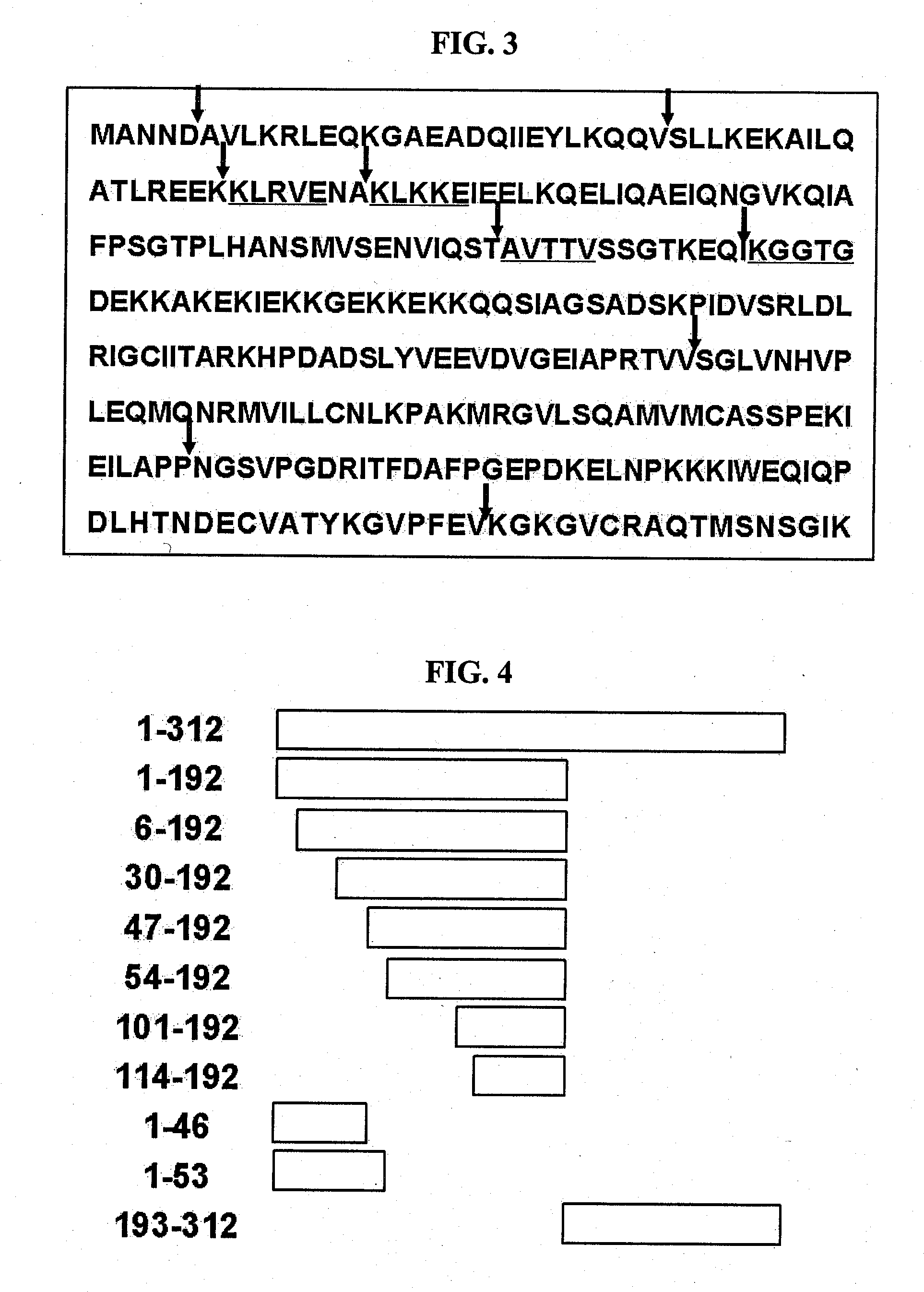Novel peptide and use thereof
a peptide and peptide technology, applied in the field of new peptides, can solve the problems of cleavage of the peptide bond, damage to the blood vessels, bleeding in lesions, etc., and achieve the effect of promoting fibroblast proliferation and wound healing
- Summary
- Abstract
- Description
- Claims
- Application Information
AI Technical Summary
Benefits of technology
Problems solved by technology
Method used
Image
Examples
example 1
Identification of Elastase 2-Cleaved Sites of AIMP1 and Construction of AIMP1 Deletion Fragments
[0066]To identify the regions of AIMP1 which is cleaved by elastase 2, the N-terminal amino acid sequence of the elastase 2-cleaved AIMP1 fragments obtained in Test Example were determined by N-terminal amino acid sequencing using the Edman degradation method and an automated sequence analyzer, and the cleaved sites of AIMP were identified (see FIG. 3).
[0067]According to the sequence information determined as described above, several deletion mutants of the AIMP1, i.e., AIMP1-(1-192), AIMP1-(6-192), AIMP1-(30-192), AIMP1-(47-192), AIMP1-(54-192), AIMP1-(101-192), AIMP1-(114-192), AIMP1-(1-46), AIMP1-(1-53) and AIMP1-(193-312) fragments, were constructed (see FIG. 4). Each of the fragments was amplified by PCR using AIMP1 cDNA (SEQ ID NO: 9) as a template with specific primer sets (Table 1). The PCR was performed in the following conditions: 95° C. for 2 min; 30 cycles of 95° C. for 30 se...
example 2
Identification of AIMP1 Domain Having Activity of Stimulating Fibroblast Proliferation
[0069]In order to examine the fibroblast proliferation activities of the recombinant proteins constructed in Example 1, foreskin fibroblast cells were treated with each of the recombinant proteins in the same manner as in Test Example , and the proliferation of the fibroblast cells was examined.
[0070]From the test results, it could be found that the N-terminal region of the AIMP1 stimulated the proliferation of fibroblast cells. Specifically, AIMP1-(1-312) (SEQ ID NO: 8), AIMP1-(1-192) (SEQ ID NO: 5), AIMP1-(1-46) (SEQ ID NO: 2), AIMP1-(1-53) (SEQ ID NO: 3) and AIMP1-(6-192) (SEQ ID NO: 4) showed high proliferation-inducing activity, but AIMP1-(30-192), AIMP1-(47-192), AIMP1-(54-192), AIMP1-(101-192), AIMP1-(114-192) and AIMP1-(193-312) did not (see FIG. 6). These results suggest that the N-terminal region of AIMP1, especially AIMP1-(6-46), be a domain that induces the proliferation of fibroblast c...
example 3
Fibroblast Proliferation-stimulating Activity of AIMP1-(6-46) Fragment
[0071]To prove the supposition that AIMP1-(6-46) is a domain that induces the proliferation of fibroblast cells, an AIMP1-(6-46) fragment was synthesized and the fibroblast proliferation-stimulating activity thereof was examined.
[0072] Construction of AIMP1-(6-46) Fragment
[0073]A peptide (SEQ ID NO: 1) corresponding to amino acids 6-46 of AIMP1 was synthesized and the effect of the peptide on fibroblast proliferation was analyzed. The AIMP1-(6-46) fragment was prepared by PCR using AIMP1 cDNA as a template with the following specific primer set (SEQ ID NO: 30 and SEQ ID NO: 31). The PCR was performed under the following conditions: 95° C. for 2 min; 30 cycles of 95° C. for 30 sec, 56° C. for 30 sec and 72° C. for 1 min; and 72° C. for 5 min.
(SEQ ID NO: 30)Sense primer of AIMP1-(6-46):5′-CGG AAT TCG CTG TTC TGA AGA GAC TGG AGC AG-3′(SEQ ID NO: 31)Antisense primer of AIMP1-(6-46):5′-GTC TCG AGT TAC TTC TCT TCC CTC A...
PUM
| Property | Measurement | Unit |
|---|---|---|
| Fraction | aaaaa | aaaaa |
| Pharmaceutically acceptable | aaaaa | aaaaa |
Abstract
Description
Claims
Application Information
 Login to View More
Login to View More - R&D
- Intellectual Property
- Life Sciences
- Materials
- Tech Scout
- Unparalleled Data Quality
- Higher Quality Content
- 60% Fewer Hallucinations
Browse by: Latest US Patents, China's latest patents, Technical Efficacy Thesaurus, Application Domain, Technology Topic, Popular Technical Reports.
© 2025 PatSnap. All rights reserved.Legal|Privacy policy|Modern Slavery Act Transparency Statement|Sitemap|About US| Contact US: help@patsnap.com



